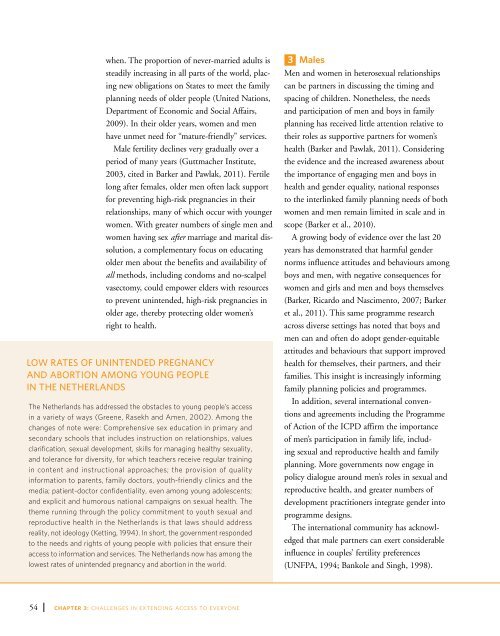State of World Population 2012 - Country Page List - UNFPA
State of World Population 2012 - Country Page List - UNFPA
State of World Population 2012 - Country Page List - UNFPA
You also want an ePaper? Increase the reach of your titles
YUMPU automatically turns print PDFs into web optimized ePapers that Google loves.
when. The proportion <strong>of</strong> never-married adults is<br />
steadily increasing in all parts <strong>of</strong> the world, placing<br />
new obligations on <strong>State</strong>s to meet the family<br />
planning needs <strong>of</strong> older people (United Nations,<br />
Department <strong>of</strong> Economic and Social Affairs,<br />
2009). In their older years, women and men<br />
have unmet need for “mature-friendly” services.<br />
Male fertility declines very gradually over a<br />
period <strong>of</strong> many years (Guttmacher Institute,<br />
2003, cited in Barker and Pawlak, 2011). Fertile<br />
long after females, older men <strong>of</strong>ten lack support<br />
for preventing high-risk pregnancies in their<br />
relationships, many <strong>of</strong> which occur with younger<br />
women. With greater numbers <strong>of</strong> single men and<br />
women having sex after marriage and marital dissolution,<br />
a complementary focus on educating<br />
older men about the benefits and availability <strong>of</strong><br />
all methods, including condoms and no-scalpel<br />
vasectomy, could empower elders with resources<br />
to prevent unintended, high-risk pregnancies in<br />
older age, thereby protecting older women’s<br />
right to health.<br />
Low rates <strong>of</strong> unintended pregnancy<br />
and abortion among young people<br />
in the netherlands<br />
The Netherlands has addressed the obstacles to young people’s access<br />
in a variety <strong>of</strong> ways (Greene, Rasekh and Amen, 2002). Among the<br />
changes <strong>of</strong> note were: Comprehensive sex education in primary and<br />
secondary schools that includes instruction on relationships, values<br />
clarification, sexual development, skills for managing healthy sexuality,<br />
and tolerance for diversity, for which teachers receive regular training<br />
in content and instructional approaches; the provision <strong>of</strong> quality<br />
information to parents, family doctors, youth-friendly clinics and the<br />
media; patient-doctor confidentiality, even among young adolescents;<br />
and explicit and humorous national campaigns on sexual health. The<br />
theme running through the policy commitment to youth sexual and<br />
reproductive health in the Netherlands is that laws should address<br />
reality, not ideology (Ketting, 1994). In short, the government responded<br />
to the needs and rights <strong>of</strong> young people with policies that ensure their<br />
access to information and services. The Netherlands now has among the<br />
lowest rates <strong>of</strong> unintended pregnancy and abortion in the world.<br />
3 Males<br />
Men and women in heterosexual relationships<br />
can be partners in discussing the timing and<br />
spacing <strong>of</strong> children. Nonetheless, the needs<br />
and participation <strong>of</strong> men and boys in family<br />
planning has received little attention relative to<br />
their roles as supportive partners for women’s<br />
health (Barker and Pawlak, 2011). Considering<br />
the evidence and the increased awareness about<br />
the importance <strong>of</strong> engaging men and boys in<br />
health and gender equality, national responses<br />
to the interlinked family planning needs <strong>of</strong> both<br />
women and men remain limited in scale and in<br />
scope (Barker et al., 2010).<br />
A growing body <strong>of</strong> evidence over the last 20<br />
years has demonstrated that harmful gender<br />
norms influence attitudes and behaviours among<br />
boys and men, with negative consequences for<br />
women and girls and men and boys themselves<br />
(Barker, Ricardo and Nascimento, 2007; Barker<br />
et al., 2011). This same programme research<br />
across diverse settings has noted that boys and<br />
men can and <strong>of</strong>ten do adopt gender-equitable<br />
attitudes and behaviours that support improved<br />
health for themselves, their partners, and their<br />
families. This insight is increasingly informing<br />
family planning policies and programmes.<br />
In addition, several international conventions<br />
and agreements including the Programme<br />
<strong>of</strong> Action <strong>of</strong> the ICPD affirm the importance<br />
<strong>of</strong> men’s participation in family life, including<br />
sexual and reproductive health and family<br />
planning. More governments now engage in<br />
policy dialogue around men’s roles in sexual and<br />
reproductive health, and greater numbers <strong>of</strong><br />
development practitioners integrate gender into<br />
programme designs.<br />
The international community has acknowledged<br />
that male partners can exert considerable<br />
influence in couples’ fertility preferences<br />
(<strong>UNFPA</strong>, 1994; Bankole and Singh, 1998).<br />
54 CHAPTER 3: CHALLENGES IN EXTENDING ACCESS TO EVERYONE
















